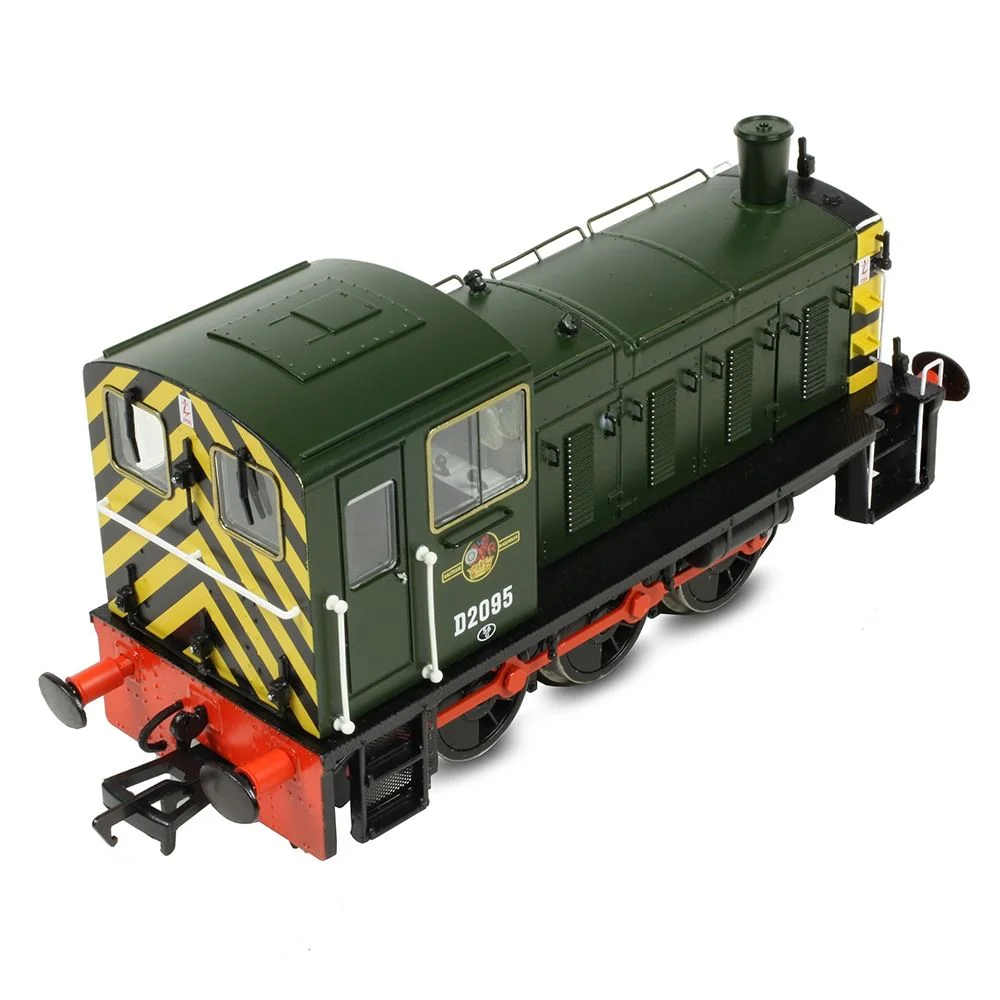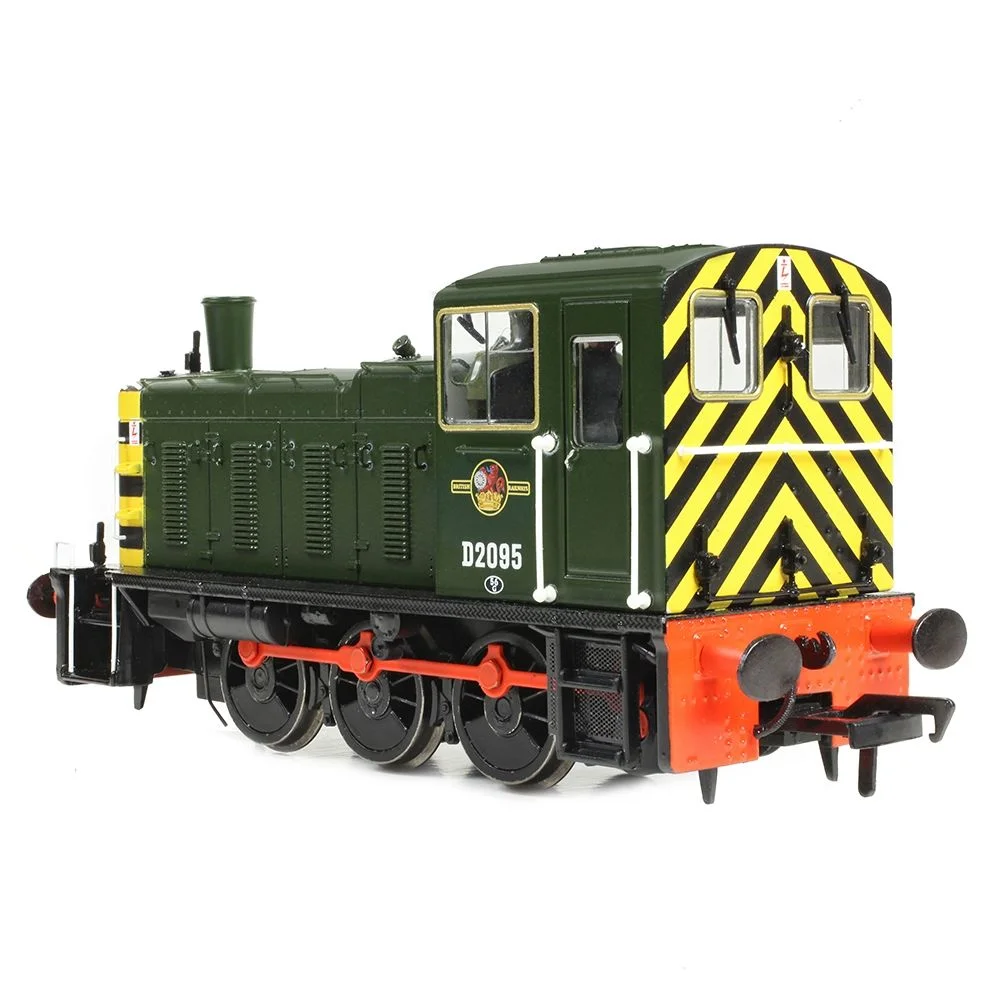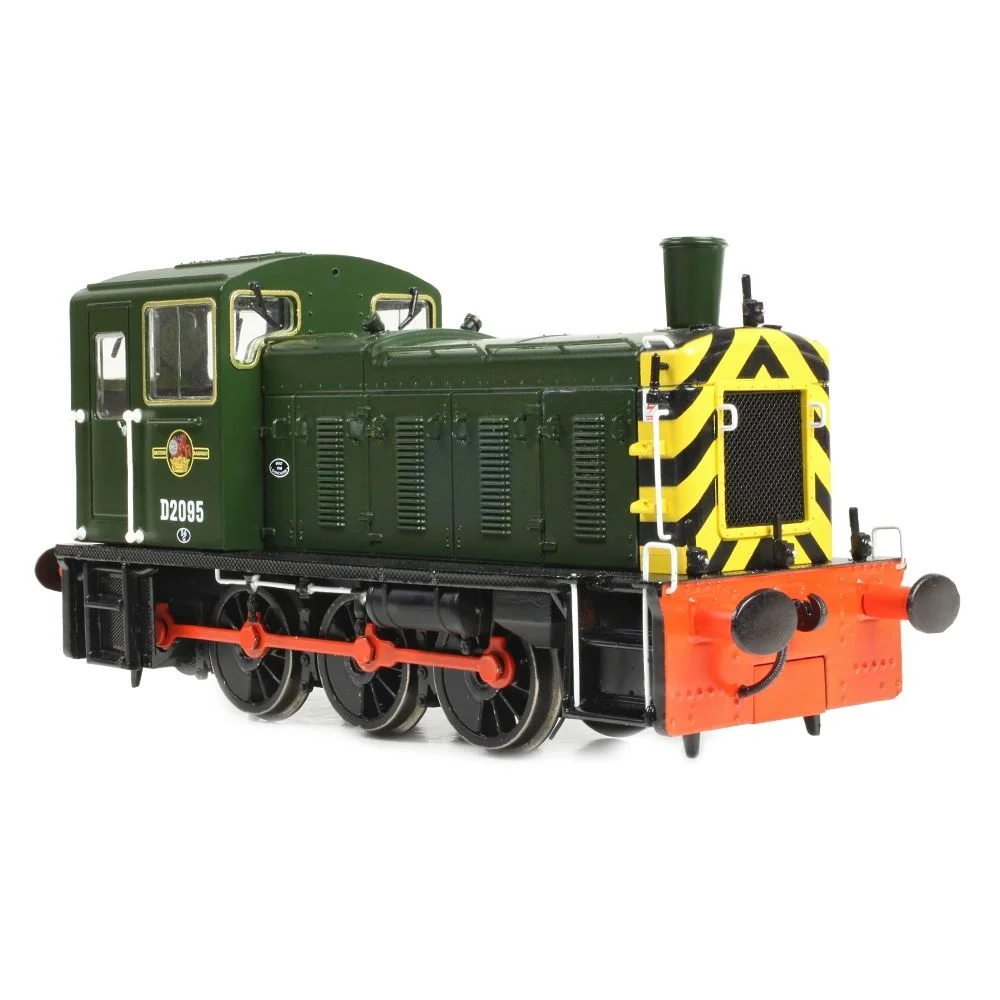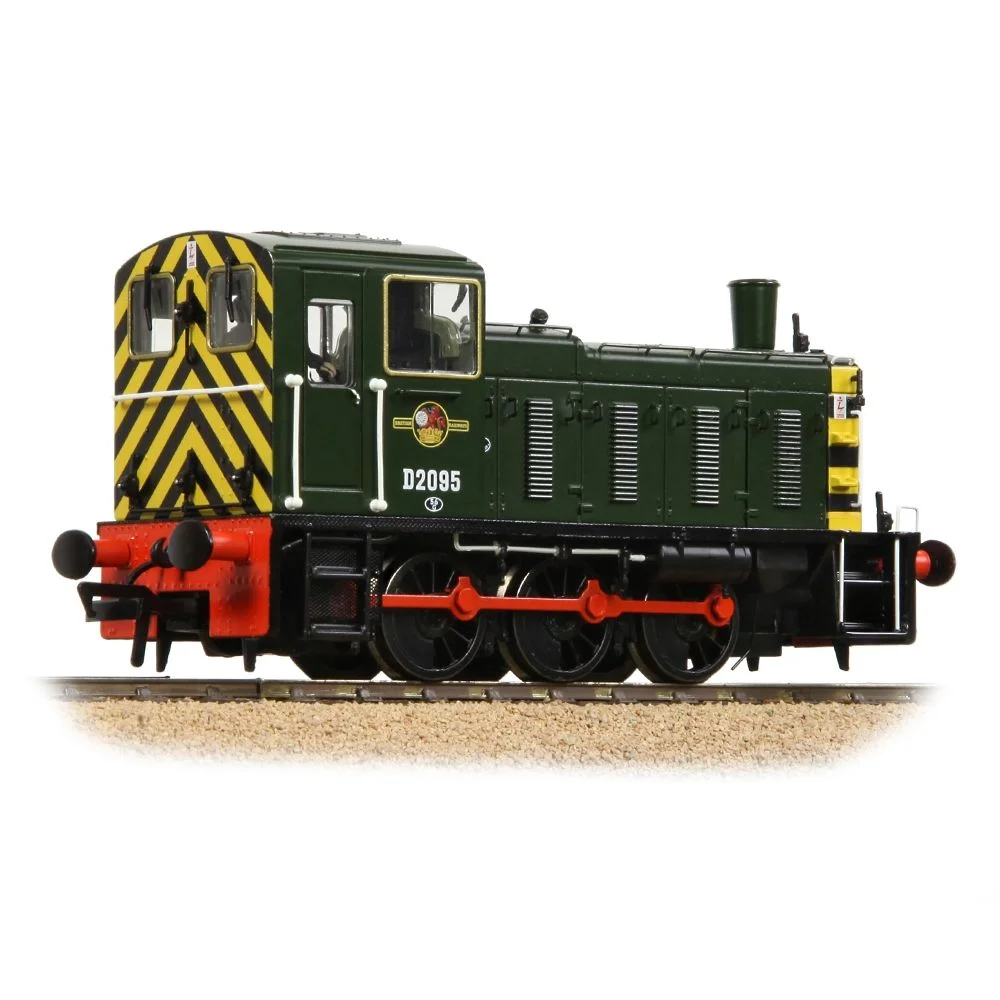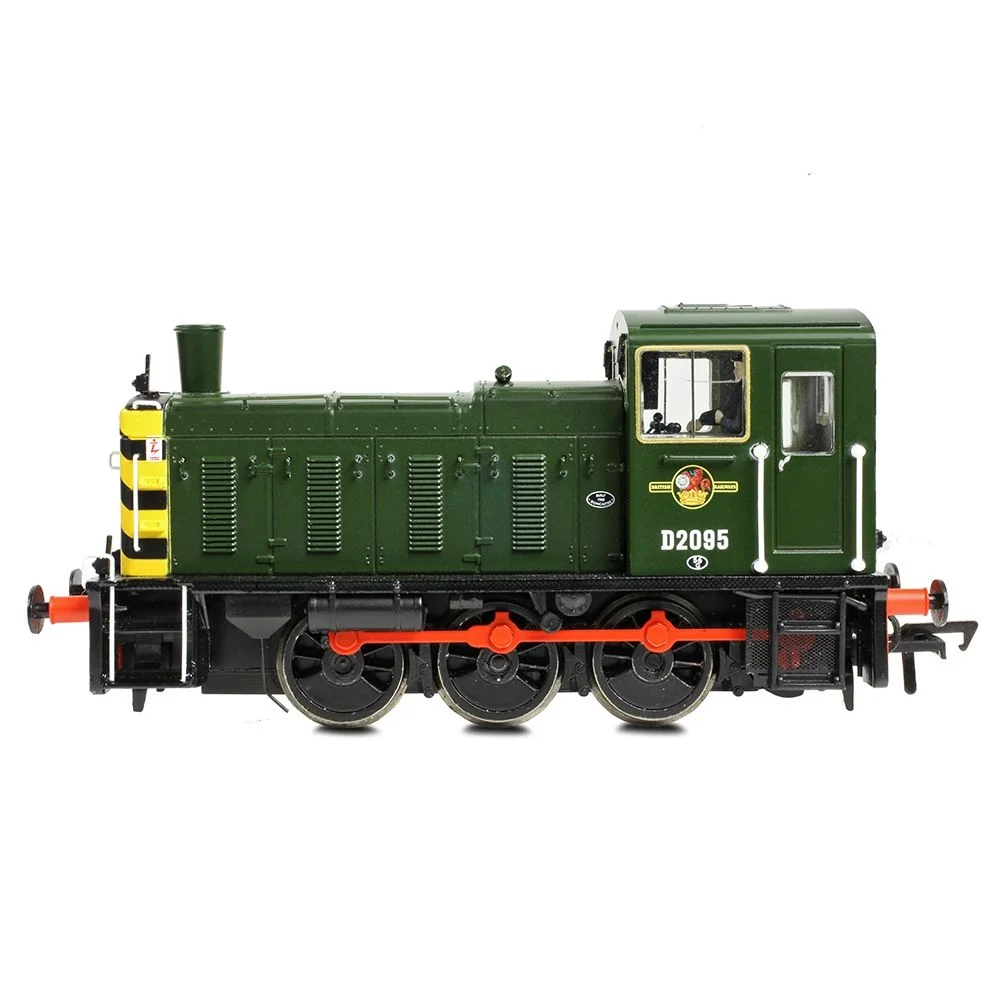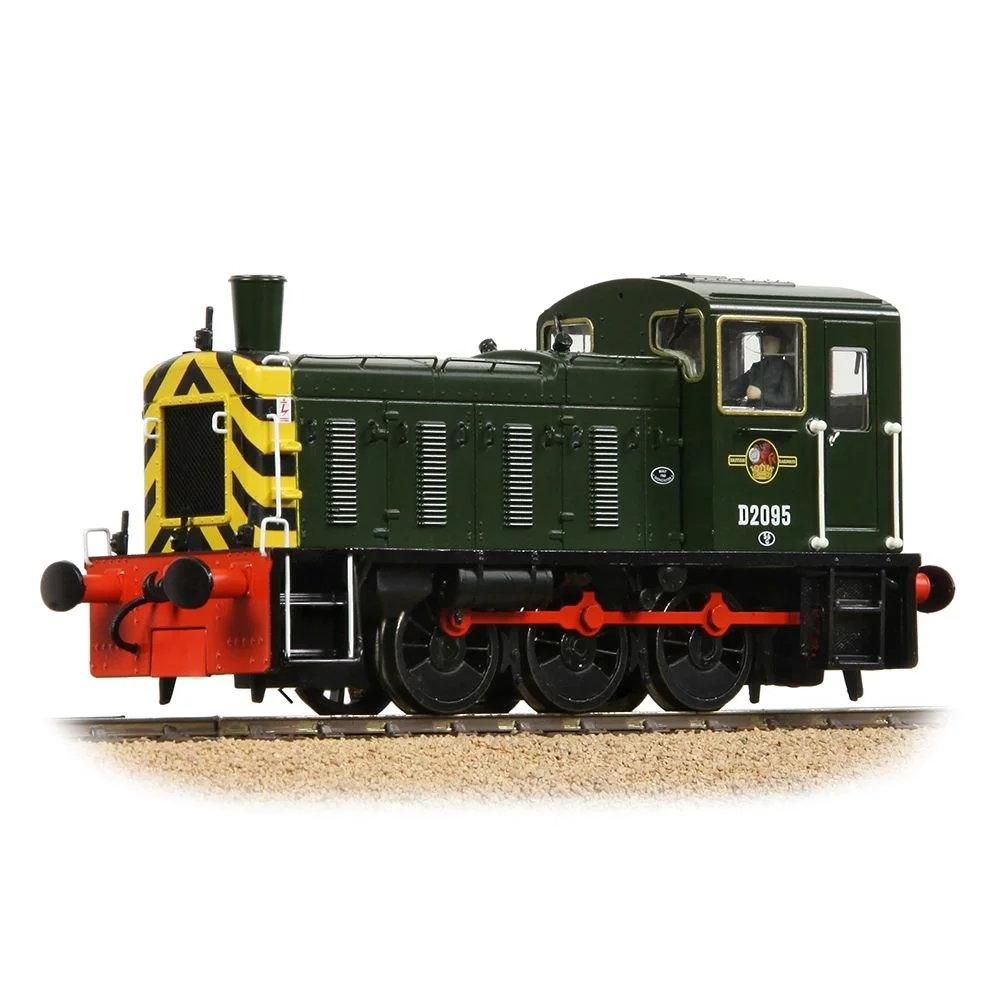Bachmann 31-364ASF
British Rail Class 03 D2095 British Railways Green with Wasp Stripes
Tooling
In 2017, Bachmann announced a complete retooling of its OO gauge British Rail Class 03 shunter, replacing the 2010 design with an all-new model built to modern standards. This upgrade delivered exceptional fidelity, improved mechanical engineering, and full digital capability, positioning the Class 03 as one of the most detailed and technically advanced small shunters in the Bachmann Branchline range.
Tooling Features
- Scale: OO gauge (1:76), designed for first-radius curves (371 mm) and above.
- Construction: Completely new tooling with a highly detailed plastic bodyshell, separate handrails, lamp irons, etched grilles, and fine pipework. The chassis is die-cast for strength and weight.
- Detailing: Fully detailed cab interior with painted controls and crew figure, flush glazing, prototypical buffer beam detail, and accurate jackshaft representation.
- Couplings: Equipped with NEM pockets and tension-lock couplings; optional cosmetic buffer beam fittings supplied for scale appearance.
Mechanical & Electrical
- Motor & Drive: High-quality coreless motor with precision gearing for smooth, slow-speed control; all axles driven.
- Pickups: Comprehensive wheel pickup for reliable electrical continuity.
- Minimum Radius: Operates on first-radius curves, making it suitable for compact layouts.
- Lighting: Factory-fitted directional LED lighting and illuminated cab (on DCC operation).
- Weighting: Die-cast chassis ensures excellent traction and stability.
DCC Capability
- Factory-fitted with a Next18 decoder socket for easy DCC installation.
- Sound-fitted versions available with ZIMO decoder and speaker pre-installed.
- Provision for stay-alive capacitors and speaker upgrades for enhanced performance.
Liveries Produced
The 2017 tooling has been released in a wide range of authentic liveries, including:
- BR green with early and late crests
- BR blue with wasp stripes
- Departmental and industrial schemes
- Special editions for preservation-era locomotives
Reviews & Commentary
- Widely praised for its exceptional detailing, including fine handrails, etched components, and accurate paint application.
- Performance reviews highlight smooth, quiet running and excellent slow-speed control, ideal for shunting duties.
- Criticism is minimal, with occasional comments on tight internal space for aftermarket sound upgrades.
Media & Social Media Insights
- YouTube reviews showcase the model’s lighting features, cab detail, and sound quality on factory-fitted versions.
- Forum discussions note the ease of decoder installation and reliability of the Next18 interface.
- Collectors regard this tooling as a benchmark for small diesel shunters in OO gauge.
Other Interesting Information
- Accessory packs include buffer beam detailing parts and scale couplings for display use.
- Recommended running-in period improves gearbox bedding and long-term performance.
- The model’s compact size and first-radius capability make it ideal for micro-layouts and shunting puzzles.
Bachmann's Description & Specifications
We are delighted to welcome the Class 03 Diesel Shunter back to the Bachmann Branchline OO scale range. Taking advantage of the technical upgrades undertaken to the popular Branchline model a few years ago, this Class 03 features a coreless motor, Next18 DCC decoder socket and has space for a speaker for those wishing to add sound – or why not opt for our SOUND FITTED model which has a Speaker and DCC Sound Decoder pre-fitted.
The Bachmann Branchline model combines a detailed chassis, depicting the jackshaft drive arrangement of the prototype and complete with sandboxes, sandpipes and underframe equipment, with a high fidelity bodyshell adorned with numerous separately-fitted detail parts. The distinctive bonnet doors are fitted with separate handrails, with further separate handrails to be found around the cab, at the front of the locomotive and on the running plate. Lamps irons and windscreen wipers are each fitted individually, as is the flowerpot chimney and the turned metal air horn. With NEM coupling pockets, the standard tension lock couplings can be removed and replaced with the supplied filling piece to complete the look of the deep bufferbeams that are a feature of the prototype. Finished with an exquisite livery application using authentic colours, logos and fonts, this is an attractive addition to any OO scale collection.
We are delighted to welcome No. D2095 in BR Green livery with the distinct wasp stripes at either end.
- Bachmann Branchline OO Scale
- Era 5
- Pristine BR Green (Wasp Stripes) livery
- Running No. D2095
- Flowerpot Chimney
- Radiator-side Steps
- Single Air Horn
- NEM Coupling Pockets
- Sprung Buffers
- Powerful Coreless Motor
- Detailed Cab Interior with pre-fitted Driver in one cab
- Cab Lighting (when used on DCC only)
- Locomotive Ready to Accept a Speaker
- Accessory Pack
- SOUND FITTED - Fitted with a Zimo MS590N18 DCC Sound Decoder
- Length 105mm
Class & Prototype
- Class: British Rail Class 03
- Traction: Diesel
- Transmission: Mechanical
- Built: 1957-1961
- Total Built: 230
- Running Number: D2095
- Ordered By: British Railways
- Built By: British Railways
- Built At: Doncaster
- Built: 06/1960
- Withdrawn: 12/1975
- Length of Service: 15.5 years
- Running Numbers: BR D2095, BR 03095
- Names: -
The BR Class 03 was British Railways' standard light diesel-mechanical shunter, with 230 built at Doncaster and Swindon Works between 1957-1962. Powered by the legendary Gardner 8L3 engine and featuring distinctive jackshaft drive with coupling rods, these 30-ton locomotives excelled on weight-restricted lines, docks, and industrial sidings where heavier Class 08s couldn't operate. Notable variants included nine cut-down cab examples for the Burry Port & Gwendraeth Valley Railway and two for Isle of Wight tunnel clearance. With 56 preserved (24% survival rate) and the last example working until 2008, the Class 03 remains popular with heritage railways and modellers alike.
Operator & Livery
- Operator: British Railways
- Livery: Green with Wasp Stripes
- Era: 5 - British Railways Late Crest
British Railways transformed Britain's fragmented rail network into a unified national system following nationalisation on 1st January 1948. Created from the "Big Four" companies under the Transport Act 1947, BR operated most of Great Britain's railways until rebranding as British Rail in 1965, managing over 20,000 route miles and inheriting nearly 20,000 locomotives of diverse designs.
The organisation pioneered standardisation through its revolutionary BR Standard locomotive programme (1951-1960), producing 999 advanced steam engines under Robert Riddles' direction. These included the versatile Britannia Pacifics, mighty 9F freight engines, and mixed-traffic classes that incorporated the best features from all predecessor companies. The 1955 Modernisation Plan accelerated diesel and electric traction development, creating fascinating mixed-traction operations.
Notable achievements included establishing unified locomotive classification systems, introducing distinctive corporate liveries, and managing the complex transition from steam to modern traction. BR's six regional structure preserved operational diversity whilst enabling standardisation of practices, signalling, and rolling stock that had eluded private enterprise for over a century.
The BR era represents steam traction's final flowering alongside emerging diesel technology, creating unparalleled locomotive variety. Today, this heritage remains highly popular with railway enthusiasts through extensive preserved fleets, heritage railway operations, and comprehensive model ranges from manufacturers like Hornby, Bachmann, and Dapol, making BR subjects essential for authentic post-war British railway modelling across all scales.
The Green with Wasp Stripes livery emerged around 1960 as a safety enhancement for British Railways shunting locomotives. This distinctive scheme combined the standard green body colour with bold yellow and black diagonal chevron patterns applied to cab ends, creating high-visibility warning stripes that mimicked natural wasp colouration.
Applied primarily to shunting classes including the Class 03, Class 08, and Class 14 locomotives, the wasp stripes were designed to improve visibility and safety around busy freight yards and industrial sites. The rollout was gradual, taking nearly a decade to reach all BR shunters, with application becoming more common throughout the 1960s.
This practical livery variant represented BR's evolving approach to railway safety during the diesel era, maintaining traditional green heritage whilst incorporating modern safety markings. For modellers, it perfectly captures the utilitarian character of British Railways freight operations during the transitional period from steam to diesel traction.
